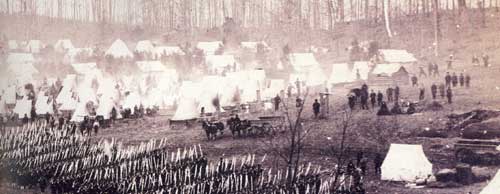The Civil War (documentary)
|
|
The Civil War was a highly popular and acclaimed PBS documentary about the American Civil War created by Ken Burns, and released on PBS in September 1990.
Episode Guide
The documentary consists of nine episodes and makes extensive use of over 16,000 archival photographs, paintings, and newspaper images from the time of the war, intermixed with contemporary cinematography, music, narration by David McCullough, anecdotes and insights from historians such as Shelby Foote, and a chorus of first person voices from famous persons such as Sam Waterston, Jason Robards, Garrison Keillor, and Morgan Freeman, who read quotes from the historic figures of the period. The film was remastered on the twelfth anniversary of its release, and a book following the movie has also been released.
Episode 1, "The Cause: 1861," introduces the players in this most tragic of American dramas, from Abraham Lincoln and Frederick Douglass to William Lloyd Garrison and Robert E. Lee. The narrative progresses from the origins of the war and the first hostilities at Fort Sumter to the aftermath of the First Battle of Bull Run (First Manassas) and George B. McClellan being placed in charge of the Union Army. The concluding section, "Honorable Manhood," includes the letter written by Major Sullivan Ballou of the 2nd Rhode Island to his wife Sarah back home in Smithfield, a week before he was killed at Bull Run.
Episode 2, "A Very Bloody Affair: 1862," details McClellan's Peninsula Campaign in the East and Ulysses S. Grant's military successes in the West, climaxing in the Battle of Shiloh. Other notable moments cover the clash of ironclads with the USS Monitor and the CSS Virginia (Merrimac), the fall of New Orleans to David G. Farragut's Federal fleet, as well as the introduction of cavalry commander and guerrilla leader Nathan Bedford Forrest as a military genius.
Episode 3, "Forever Free: 1862," tells the story of how a series of events culminating in the Battle of Antietam, which turned back Lee's first invasion of the North, gave President Lincoln the political opportunity to issue the Emancipation Proclamation. Although McClellan's Peninsula Campaign to move on Richmond fizzled out, the "Little Napoleon" is placed back in command of the Army of the Potomac after the Federal troops lose a Second Battle of Bull Run under John Pope. Trying to gain respite for the people of Virginia and to put pressure on the North, Lee invades Maryland, not knowing that the outcome of the battle outside Sharpsburg will give Lincoln the "victory" he needs to move the war to a higher plane and prevent any European power from coming to the aid of the Confederacy.
Episode 4, "Simple Murder: 1863," focuses on the futile stupidity of the Union assault on Marye's Heights during the Battle of Fredericksburg and the brilliant audacity of Lee's strategy at the Battle of Chancellorsville, while out West, Grant lays siege to Vicksburg. However, all of the Confederate successes are tempered by the death of Stonewall Jackson and Lee's fatal plan to invade the North a second time.
Episode 5, "Universe of Battle: 1863," covers the Battle of Gettysburg and the fall of Vicksburg, which mark the turning point of the Civil War. Those familiar with Michael Shaara's novel The Killer Angels or the film Gettysburg will find Joshua Lawrence Chamberlain featured prominently in this episode. There is also a section devoted to the African-American troops who fought for the Union during the war, contrasted with the Northern riots against Emancipation. The episode ends with the war moving from Tennessee to Georgia and Lincoln's Gettysburg Address. The most memorable moments on this tape come from Daisy Turner, the 104-year-old daughter of a former slave, reciting a poem about the death of a soldier.
Episode 6, "Valley of the Shadow of Death: 1863," begins with Lincoln finally finding a general with the will to fight with the full strength as his disposal as Ulysses S. Grant comes East and takes command of the Union forces. This episode follows the movement of the Army of the Potomac in the Overland Campaign, from the Battle of the Wilderness to the start of the siege at Petersburg, Virginia.
Episode 7, "Most Hallowed Ground: 1864," has the re-election of Abraham Lincoln as the focal point. While Grant and the Army of the Potomac are stalled in the trenches outside Petersburg, it is William Tecumseh Sherman's assault on Atlanta and his March to the Sea with the Army of Tennessee that gives Lincoln the momentum needed to defeat his political opponent, the democratic nominee McClellan. Other key segments of this episode cover the infamous Battle of the Crater and Philip Sheridan's brutal campaign in the Shenandoah Valley.
Episode 8, "War is Hell: 1865," finds the war finally coming to an end. Sherman marches to the sea and Richmond finally falls to Grant, setting up Lee's surrender at Appomattox Court House and the assassination of Lincoln.
Episode 9, "The Better Angels of Our Nature: 1865" is the epilogue to the series. The war is finally over and after touching upon the execution of those involved in the Lincoln assassination and the review of the Grand Armies of the Republic, the primary focus is on what happened to the people featured throughout the documentary. This includes not only the fates of generals such as Grant and Lee, but also what happened to soldiers such as Elisha Hunt Rhodes and Sam Watkins when they returned from the war. The most memorable moment comes at the very end, with film of the 50th reunion of the Blue and the Gray at Gettysburg and a reenactment of Pickett's Charge.
The theme song of the documentary, "Ashokan Farewell," which was performed for the film by its composer Jay Ungar, became so closely associated with the war thanks to the film that people frequently and erroneously believe it was written and performed during the Civil War.
External link
- PBS: The Civil War (http://www.pbs.org/civilwar/)

